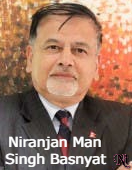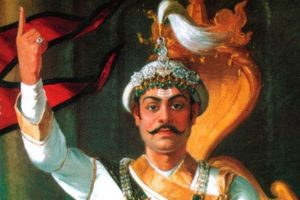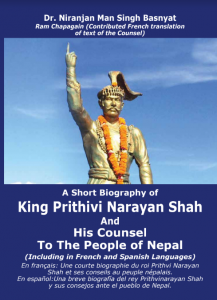Ambassador Dr. Niranjan Man Singh Basnyat
Kathmandu, Nepal

King Prithvi Narayan Shah had given the responsibility of Kantipur to his son Pratap Singh and was living in Nuwakot. The king was exhausted physically as well as mentally after a lifetime of hardship, especially the mental and physical toll taken up by the unification campaign. When Abhiman Singh was administering the newly conquered territory of Nepal in the east, he received the news that King Prithvi Narayan Shah has become seriously ill in Nuwakot.
He handed over all administrative work to his juniors in Bijayapur and headed towards Nuwakot to have one last opportunity to meet with the first king of Nepal. It was believed that his brothers, Kazi Nahar Singh and Kazi Dhaukal Singh, also joined him to see the ailing king. Other major courtiers had also assembled in Nuwakot to see the dying King.

King Prithvi Narayan Shah passed away in the morning of Wednesday 11 January 1775 at the confluence of rivers Suryamati (Tadi) and Trishuli at Devighat of Nuwakot at the age of fifty-two and four days. The place is also called Mohan Tirtha.
Queen Narendra Laxmi Shah immediately sent the Crown of the King to Kathmandu for Prince Pratap Singh Shah before she became sati with eight other mistresses of her husband.
After Prithvi Narayan Shah’s death, Prince Pratap Singh, eldest among Prithvi’s three sons, ascended the throne of Nepal in Kathmandu. He was born on Tuesday 10 June 1749. Prince Bahadur Shah was the second son of Prithvi Narayan who was born on Thursday 16 June 1757 in Nuwakot. A third prince was also born. There is a mention of Narayan Shah as the youngest prince, but it is believed that he died in infancy.
These Princes were all born from Queen Narendra Laxmi.
According to historian Mahesh Chandra Regmi, significant territories were already annexed to Gorkha and later to Nepal by January 1775. “In 1775, when Prithvi Narayan Shah died at Nuwakot at the age of 53, the Gorkhali Kingdom comprised the whole of the eastern Tarai (Morang, Sunsari, Jhapa, Saptari, Siraha, Sarlahi, Mahottari, Dhanusha, Bara, Parsa and Rautahat), the eastern and central inner Tarai (Sindhuli, Udayapur, Chisapani and Makwanpur), the whole of Kathmandu Valley, the eastern hill region up to the Tista river bordering Sikkim, and the western hill areas of Nuwakot and Dhading between Gorkha and Kathmandu. The principality of Jajarkot on the borders of the Baisi region had signed a treaty accepting Gorkha’s suzerainty in January 1769, a few months after the conquest of Kathmandu”.
While in his deathbed, King Prithvi Narayan Shah gave his last Counsel to his brothers and courtiers in which he had enumerated his future policy to save and promote the interests of unified Nepal. In fact, it was the king’s final address to the nation. Most of the policy matters mentioned in the Counsel are still relevant to the government and people of Nepal. The original copy of this Counsel was later recovered from Maan Mandir, residence of Abhiman Singh Basnyat in Asan, by his descendant historian Bakhat Man Singh Basnyat. The contents of the Counsel had remained unknown to the people of Nepal and beyond until historian Surya Bikram Gyawali published his book entitled “Prithvi Narayan Shah” in 1935 from Darjeeling. For many years, the full text available in this book was not published or available publicly. Publication was possible only after the autocratic Rana regime was overthrown. The full text was published for the first time by Yogi Naraharinath from Banaras in 1952. Yogi had transcribed it from the original text made available by Bakhat Man Singh Basnyat.
Historian Dilli Raman Regmi has mentioned that the handwriting of original Counsel is that of Abhiman Singh Basnyat. It is believed that while Prithvi Narayan Shah was speaking, Abhiman Singh was writing his words into paper. The type of handwriting of the original text indicates that it is the handwriting of one person throughout the document. Some historians have said that it is the handwriting of Bhanu Joshi Arjyal. In the meantime, the handwriting of Bhanu Joshi Arjyal was discovered in legal papers made for the division of properties among the sons of Shivram Singh Basnyat in 1786. When compared, his handwriting does not match with the handwriting of original text of the Counsel. Similarly, a writer of linguistics has written that it was Shakti Ballabh Arjyal who wrote the text of the Counsel. But this author compared the handwriting of the original text of the Counsel with that of handwriting of Shakti Ballabh Arjyal found in his “Jayaratnakar Naatak” and concluded that it does not match. Therefore, that leaves Abhiman Singh Basnyat as one of the remaining candidates, although more research and confirmation is required.
Immediately after the death of King Prithvi Narayan Shah, Prince Bahadur Shah was arrested from Nuwakot when he was mourning the death of his father. Sworup Singh Karki had gone with troops to arrest Bahadur Shah. This was ordered by his brother King Pratap Singh Shah on the suspicion of a possible coup by uncle Daljit Shah and Bahadur Shah. It was also because Daljit Shah had suggested that Bahadur Shah should take over as the king. Daljit Shah fled to an unknown destination. His properties were confiscated.
Dalmardan Shah was also imprisoned.
The Political Leaders who assisted King Prithvi Narayan Shah:
There was no doubt about the fact that King Prithvi Narayan Shah was a leader with a strong personality. He was a unique symbol of unity of Gorkha and later of Nepal. However, the unification campaign would not have succeeded without the support of his ardent followers, in particular the political and military leaders, and the honest courtiers who were at the frontline to advance the cause of the campaign. They were also taking major political decisions on behalf of the state and the king. Till now, history books have been written mostly praising kings and their leadership. But the important contributions and sacrifices made by other military or political leaders who came from among the general public of that time of history seem to have been forgotten and ignored.
The unification of Nepal would not have been successful without their unflinching support to the king.
Kazi Kalu Pandey was instrumental in making peace with Lamjung at the time of King Narabhupal Shah in 1740 and thereafter. He was the main military leader during the conquest of Nuwakot, Lamidada and other key regions. He also played a crucial diplomatic role for the advancement of Gorkha. He was a very reliable adviser to the king.
Shivaram Singh Basnyat was the first Commander-in-Chief of Gorkha who came to attack the areas under the Kantipur kingdom. He was the first prominent courtier of Gorkha who laid down his life for the noble cause of advancing the unification campaign.

Among these leaders, the post of Chautaria was given to those who were served the function of chief of staff to the king but also served in war. Generally, this post was reserved for immediate members of the king’s family. During the period of the reign of King Prithvi Narayan Shah, Mohaddamkirti Shah, the brother of the King Prithvi Narayan Shah was appointed Chautaria. Later, when the workload for one Chautaria became heavy, another brother Dalmardan Shah was appointed Junior (Kanchha) Chautaria when he came back to Gorkha after becoming the king of Patan. He was moved from military duty to civil administration. All the four brothers assisted King Prithvi Narayan Shah wholeheartedly during the initial phase of the unification campaign. Two other brothers Dalajit Shah and Shoorpratap Shah were appointed Kazis. Chautarias were generally higher in rank than the Kazis but Kazis had more executive powers than Chautarias.
Chautarias led many of the battles for Gorkha and annexed a considerable amount of territories. Mohaddamkirti Shah provided leadership during the battle against Makwanpur, Hariharpur Gadhi and Khundaghat. Similarly, he was also the military leader for the battle against Mir Kassim’s forces. After the victory, he was made the chief of all areas under Makwanpur. Later Mohaddamkirti Shah wanted to become the king of Makwanpur or lower plains (talhatti) of Makwanpur with the tacit understanding of the British East India Company.
Dalmardan Shah was the only brother of King Prithvi Narayan Shah who was born from the same mother (Queen Kaushalyavati). He had participated in many battles for Gorkha. Dalmardan Shah wanted to become king of Patan forever again after its annexation. He was once made king of Patan earlier for a short term.
Queen Indra Kumari was honoured with the post of Chautaria by King Prithvi Narayan Shah in Gorkha. She was called Chautara Maharani. It is believed that she was brought to Gorkha from Makwanpur after many years of marriage to Prithvi Narayan Shah due to acrimonious relations with King Hemkarna Sen and Prince Digbandhan Sen. She gave birth to the only daughter of Prithvi Narayan Shah. Princess Bilas Kumari was born in 1751. Bilas Kumari was married to Crown Prince Ranabhim Shah of Salyan in 1766. In fact, it was believed that this marriage was arranged for political reasons to obtain the support of the far west region in the unification campaign.
It is surprising that King Prithvi Narayan Shah married his only daughter to a prince from a distant kingdom.
According to a well-known historian Baburam Acharya, she was accompanied by her father Hemkarna Sen to Maidi of Dhading and he finally handed over his daughter to King Prithvi Narayan Shah after the ceremony of Gauna in 1748. (Gauna is a custom and the ceremony associated with the consummation of marriage). At that time, King Hemkarna Sen presented many gifts and an elephant to King Prithvi Narayan Shah. Princess Bilas Kumari was born from her in 1751.
Kazi Daljit Shah provided leadership during the battles in Kirtipur and in Chaukot. Kazi Shoorpratap Shah hoped for a large reward for providing leadership in the victory of Bhaktapur. He had also contributed immensely in the victory of Kirtipur and Kathmandu as well as battles against Chaubisi States. But King Prithvi Narayan Shah refused to concede to the undesirable demands of his brothers. Because he did not wish to part away with the hard-earned territories to his brothers.
Kazi Ranarudra Shah was a half brother of the king who was born from the mistress of King Narabhupal Shah. His mother’s name was Premavati. Ranarudra Shah was a very dependable brother. He and Kazi Kalu Pandey were entrusted with the job of securing Gorkha during the absence of King Prithvi Narayan Shah when he was on a visit to Banaras. Along with Kazi Kalu Pandey, Mohaddamkirti Shah and others, Ranarudra Shah defended and repulsed Chaubisi states attack on Siranchowk on 16 July 1755. Again, on 18 March 1764 Chaubisi states attacked Chihan dada. Ranarudra Shah and Shoorpratap Shah chased Chaubisi troops far away. Kazi Ranarudra’s wife, widow of Shivaram Singh Birangana Shoorprabha, and other women provided food and water to the fighters reaching in the battlefield during the first battle in Siranchowk .
Kazi Tularam Pandey, Kazi Bansaraj Pandey, Kazi Kehar Singh Basnyat, and Kazi Abhiman Singh Basnyat were other very able prominent leaders of that time.
There were many other prominent political leaders at that time who took major military responsibility, as well as civil leadership during the various battles and later headed the civil administration of the conquered territories. During the reign of King Prithvi Narayan Shah (1743-1775), the first generation of prominent Gorkhali warriors besides those already mentioned above included Maheswor Pant, Biraj Bakheti, Chandra Prakash Shah, Laxmi Narayan Pandey, Vishnu Shah, Nahar Singh Basnyat, Dhaukal Singh Basnyat, Ramkrishna Kunwar, ‘Bagh’ Bhimsen Thapa, Amar Singh Thapa (Bada), Birbhadra Thapa, Shakti Ballav Arjyal, Devrishi Upadhyaya Adhikari, Ashajit Bhandari, Haribnasa Upadhyaya, Birbhadra Upadhyaya, Bansu Gurung, Shreeharsh Panth, Nandu Sardar, Jahangir Shah, Biraj Thapa Magar, Chamu Basnyat, Jaya Baniya, Ranya (Bangya) Basnyat Birbhadra Basnyat, Jibram Basnyat, and Amar Singh Kunwar.
Those who sacrificed their lives for the unification of Nepal during the reign of King Prithvi Narayan Shah were the following brave warriors: Shivaram Singh Basnyat (Sangachowk), Ambar Pandey (Siranchowk), Kalai Dwarya (Siranchowk), Kalu Pandey (Kirtipur 1st), Bagh Bhimsen Thapa (Palanchowk), Jahangir Shah (Sanga),
Jibram Basnyat (Sanga), Devrishi Upadhyaya Adhikari (Mahadevpokhari), Ashajit Bhandari (Makwanpur-Mir Qasim’s attack), Nandu Sardar (Makwanpur-Mir Qasim’s attack), Tularam Pandey (Kathmandu), Kehar Singh Basnyat (Satahun), Bir Bhadra Pathak (place not known), Jeevan Thapa (Kirtipur 1st), Laata Khatri (Kirtipur 1st), Chamu Sayela (Kirtipur 1st), Parshuram Rana (Kirtipur 1st), Sothya Danuwar (Kirtipur 1st), Birbhadra Basnyat (Kirtipur 2nd), Jaskarna Khatri Chaukot), Amar Singh Kunwar (Timal), Gangananda Acharya (Sikkim), Gajendra Singh Thapa (Sindhuli), Kuldev Singh Thapa (Sindhuli), Bajubarna Thapa (Sindhuli), Surya Man Thapa (Sindhuli), Saindhwaj Thapa (Sindhuli) Asthani Thapa Magar (Sindhuli), and Ramkrishna Khatri (place not known). These names are found in historical documents because they were definitely noteworthy leaders. But there were thousands of other unknown soldiers who were killed in fighting for the unification campaign whose names are not found in historical documents.
# To be continued.
# Next issue to begin with International Situation: Ed. Upadhyaya.
